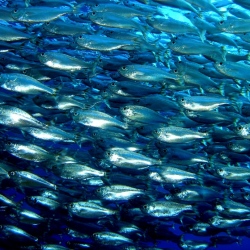
In the interest of not burying the lead: MIT is developing inflatable robotic tentacles, motor-free limbs that are able to flex and grip in response to targeted bursts of air. But the inspiration for those undulating components is a fish. And that’s the more appropriate bot to start with. As robots go, MIT’s new autonomous fishbot is a humble, single-minded machine.
It was created to curve, with a flexible, silicone rubber tail that uses carbon dioxide to power its wriggles and flaps. Each release of gas inflates one half of the tail, curving it. With alternating right inflations, the robotic fish will swim along.
It’s a neat approach to locomotion, but not the machine’s real speciality, it bleeds fuel with each movement, and the onboard CO2 tank isn’t large enough for sustained, long-distance swimming. What makes this robot interesting is what it can do in an emergency, because of its soft body.
Real, biological fish can perform what’s referred to as an escape maneuver, an extremely rapid turn intended to ditch pursuers. MIT’s robofish can do the same, using a powerful burst of CO2 to quickly whip its body to one side, turning as much as 100 degrees in roughly 100 milliseconds. It’s a high-performance move for any kind of robot, and further evidence of the importance of being soft.
The established advantages of soft bots are easy to guess at. Researchers at iRobot and Hiroshima University have shown off machines that ooze around, deforming in genuinely unsettling ways to through narrow openings, or with a minimum of sensing and control algorithms.
A robot that’s soft, in other words, might navigate its environment with fewer snags and stumbles than one that’s hard and hard-edged. The other obvious benefit of softness is safety, a squishy bot might be able bump into things or people without inflicting damage.
What MIT’s robotic fish demonstrates is less obvious: being soft can ramp up performance. A rigid system might be able to pull off something similar to the fishbot’s escape maneuver, but it would require far more mechanical complexity, and possibly some help from propellers.
By deforming along its entire length, not bending at right angles, but throughout the soft structure, the flexible tail optimizes its underwater pivot. It moves fast, and with power, without relying on a fast, powerful motor.
